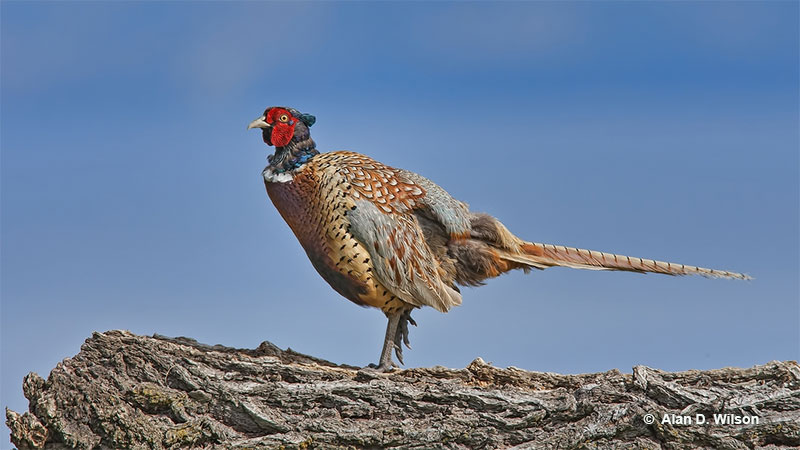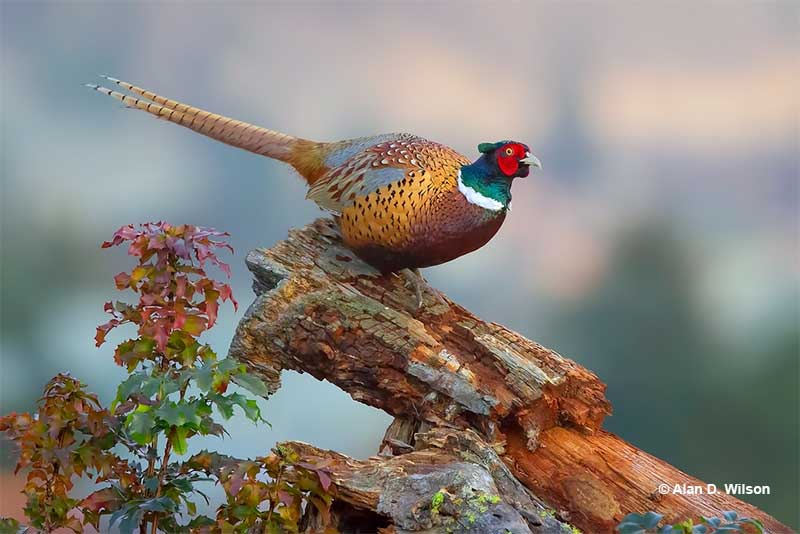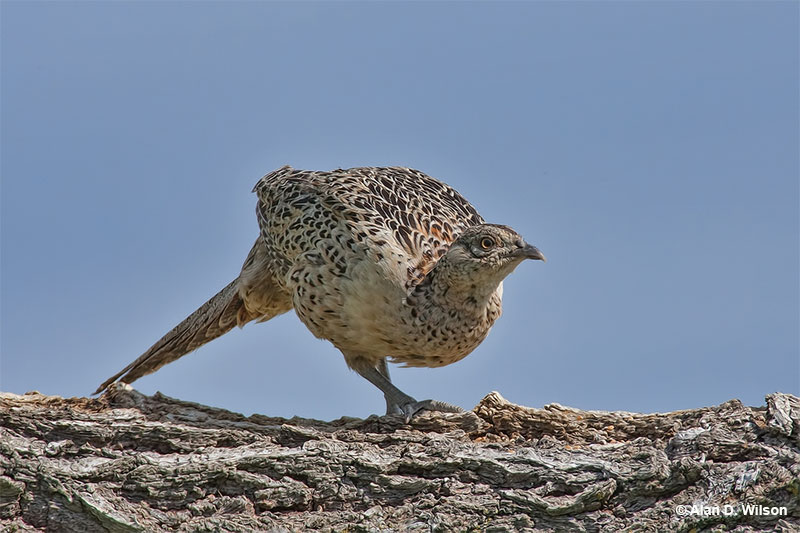
South Dakota is a north-central state with 77,116 square miles of wild prairies, duck-filled marshes, woodlands, and plenty of wide open spaces. The Mount Rushmore State is also home to 910,000 people and nearly 440 bird species!
South Dakota state bird is the Ring-necked Pheasant. Folks in South Dakota are fortunate to see this fancy bird in open areas throughout the state!
State Bird
The Ring-necked Pheasant (Phasianus colchicus) became the state bird for South Dakota on February 13th, 1943. This is the date when the State of South Dakota Legislature voted to make it an official state symbol.
Unlike most other states, South Dakota picked a non-native species to be the official state bird. However, there wasn’t any doubt about choosing the Ring-necked Pheasant. Although South Dakota does have many beautiful native bird species, the Ring-necked Pheasant has played an important role in the state for more than one hundred years.

Several individuals of this beautiful Asian bird were brought to South Dakota in 1908 and released in Spink County. Local people enjoyed watching pheasants, but as with many other places in the world, they also liked to hunt and eat them.
In South Dakota, Ring-necked Pheasants thrived in the state’s grasslands and open habitats.
Pheasant hunting quickly became popular, and the state established an official season in 1919. Since then, this gamebird species has acted as an important source of food (especially during the Great Depression) and has played a major role in the local economy.
In recognition of this bird’s importance and regal appearance, South Dakota lawmakers were happy to choose the Ring-necked Pheasant to be their state bird.
Fun Facts about Ring-necked Pheasants
- Ring-necked Pheasants are native to grassland and brushy habitats in China and central Asia. However, they have been successfully introduced to Europe, North America, Australia, and New Zealand.
- This species is also known as the Common Pheasant. Several fancy and beautiful pheasant species live in Asia, but this species is the best-known and the most common.
- To survive extremely cold weather, Ring-necked Pheasants can become dormant, reduce their metabolism, and go without eating for two weeks!
- Pheasants can run as fast as 10 miles per hour. However, if they need to fly, they burst into the air and may reach speeds of 40 miles per hour!
- Ring-necked Pheasants eat small stones and grit to help them digest hard seeds and bugs. For this reason, we often see them at the edges of roads.
- This species is one of the most important game birds in the world. In the USA, and especially in South Dakota, visiting hunters spend millions of dollars on lodging, food, guides, and hunting permits.
- Although Ring-necked Pheasants are heavily hunted, these common birds are not endangered. In most places, hunting is controlled, and the bird’s habitat and populations are carefully managed.
Identification
The male Ring-necked Pheasant is one of the easiest birds to identify. No other bird in North America has the same shape, colors, and long pointed tail. Males have a dark green or dark glossy blue head with a crest and bare red skin on their face. They also have a pale beak, and a narrow white collar.
The rest of their plumage is rich reddish-brown and copper mottled with small black spots below and pale spots and other markings on their back. They have mottled gray on their lower back and rump and black barring on their extra-long, pale brown tail.

Female Ring-necked Pheasants don’t look anything like the males and can be confused with other native grouse species. However, they always have a much longer, pointed tail. Females are overall pale brown with a small, paler head and are paler on their belly. Hen pheasants also have small dark marks and mottling on their upperparts and sides.
Both sexes also have broad wings and fairly long, stout gray legs and feet. Males have longer tails and can be 35 inches long, whereas female pheasants are around 21 inches in length. Males and females also have a 31-inch wingspan and weigh around 2.5 pounds.
What do Ring-necked Pheasants eat?
Ring-necked Pheasants are omnivores with a diet very similar to chickens and other grouse-like birds. They eat lots of insects like beetles and caterpillars, other small invertebrates, seeds, grain, vegetable shoots, roots, and berries. Pheasants are very adaptable birds that also like corn, soybeans, and many other similar foods. On occasion, they even catch and eat small lizards!
Not only do they eat a lot of the same foods as chickens do, pheasants also forage like poultry!
Like chickens and quail, Ring-necked Pheasants often form small flocks that frequent open areas. However, they prefer to feed next to brush, tall grass, and other places where they can hide. To find food, pheasants slowly move along and keep an eye out for grain and bugs. When they spot food, they quickly reach down to pick it up with their beak.
In fall and winter, they often feed on leftover grain in open farm fields. When feeding like this, pheasants can stay in one spot and pick up one seed after another. This is also how they eat food at bird feeders.
Pheasants also scratch the ground to reveal seeds and worms and can fly into bushes and trees to eat berries.
Call
Ring-necked Pheasants make a variety of quiet calls but are best known for the male’s “song”. In places where pheasants live, this harsh vocalization is a typical sound in farming areas and is usually heard at dawn and dusk.
It can carry for ways and is an odd, harsh “crowing” call that sounds like, “koohKOK”. While calling, males also rapidly beat their wings to make a drumming or whirring sound. However, you have to be pretty close to the bird to hear it.
Behavior
Ring-necked Pheasants aren’t that difficult to see. If you look for them in the early morning on quiet roads through farm fields and grasslands, you have a pretty good chance of seeing this striking bird.
Although they tend to hide in dense grass or brush during the day, they do like to forage in open farm fields, especially in the fall and winter. These birds often occur in small flocks and spend most of their time foraging on the ground for seeds, grain, and insects.

Once in a while, we also see Ring-necked Pheasants in flight, but mostly when they are accidentally flushed out of cover.
Pheasants nest on the ground in areas with dense grass and lay anywhere from 6 to 15 eggs! After the babies hatch, they leave the nest to follow their mother around for several weeks.
The young birds find their own food and can also fly when they are 12 days old.
Ring-necked Pheasants don’t pose any threat to cats, dogs, or people. However, they do have to deal with threats to them. These birds are hunted in most parts of their range and are preyed on by snakes, cats, foxes, coyotes, hawks, owls, and other predators.
Keep learning – Most common birds of South Dakota
Frequently Asked Questions
What is the state bird of South Dakota?
The state bird of South Dakota is the Ring-necked Pheasant.
Why is the Ring-necked Pheasant the state bird of South Dakota?
The Ring-necked Pheasant is the state bird of South Dakota because it is a common, fancy, and popular bird to watch and hunt.
When did South Dakota choose its state bird?
South Dakota chose its state bird on February 13th, 1943.
What is South Dakota’s state animal?
South Dakota’s state animal is the Coyote.
What is the state flower of South Dakota?
The state flower of South Dakota is the American Pasque.

